Preparation, Characterization of New Antimicrobial Antitumor Hybrid Semi-Organic Single Crystals of Proline Amino Acid Doped by Silver Nanoparticles
Abstract
:1. Introduction
2. Experimental
2.1. Materials and Methods for Preparation of Single Crystals
2.2. Characterization of Single Crystals
3. Results and Discussion
4. Conclusions
Supplementary Materials
Author Contributions
Funding
Institutional Review Board Statement
Informed Consent Statement
Data Availability Statement
Acknowledgments
Conflicts of Interest
References
- El Batouti, M.; Fetouh, H.A. A facile new modified method for the preparation of a new cerium-doped lanthanium cuperate perovskite energy storage system using nanotechnology. New J. Chem. 2021, 45, 8506–8515. [Google Scholar] [CrossRef]
- Polinger, V.; Bersuker, I.B. Origin of polar nanoregions and relaxor properties of ferroelectrics. Phys. Rev. B 2018, 98, 214102. [Google Scholar] [CrossRef]
- Tulina, N.A. Memristor properties of high temperature superconductors. arXiv 2018, arXiv:1801.09428. [Google Scholar]
- Tulina, N.A.; Ivanov, A.A. Memristive Properties of Oxide-based High-Temperature Superconductors. J. Supercond. Nov. Magn. 2020, 33, 2279–2286. [Google Scholar] [CrossRef]
- Poplavko, I.M. Dielectric Spectroscopy of Electronic Materials; Woodhead Publishing: Cambridge, UK, 2021. [Google Scholar]
- Kour, P.; Pradhan, S.K. Perovskite Ferroelectric. Multifunctional Ferroelectric Materials; Intech Open: London, UK, 2021; p. 31. [Google Scholar]
- Uchino, K. Ferroelectric devices; CRC Press: Boca Raton, FL, USA, 2018. [Google Scholar]
- Li, J.; Nishikawa, H.; Kougo, J.; Zhou, J.; Dai, S.; Tang, W.; Zhao, X.; Hisai, Y.; Huang, M.; Aya, S. Development of ferroelectric nematic fluids with giant-ε dielectricity and nonlinear optical properties. Sci. Adv. 2021, 7, eabf5047. [Google Scholar] [CrossRef] [PubMed]
- Critelli, R.A.; Sumodjo, P.T.; Bertotti, M.; Torresi, R.M. Influence of glycine on Co electrodeposition: IR spectroscopy and near-surface pH investigations. Electrochim. Acta 2018, 260, 762–771. [Google Scholar] [CrossRef]
- Yuan, G.; Tu, H.; Li, M.; Liu, J.; Zhao, C.; Liao, J.; Yang, Y.; Yang, J.; Liu, N. Glycine derivative-functionalized metal-organic framework (MOF) materials for Co(II) removal from aqueous solution. Appl. Surf. Sci. 2019, 466, 903–910. [Google Scholar] [CrossRef]
- Bera, S.; Guerin, S.; Yuan, H.; O’Donnell, J.; Reynolds, N.P.; Maraba, O.; Ji, W.; Shimon, L.J.W.; Cazade, P.-A.; Tofail, S.A.M.; et al. Molecular engineering of piezoelectricity in collagen-mimicking peptide assemblies. Nat. Commun. 2021, 12, 2634. [Google Scholar] [CrossRef] [PubMed]
- Huang, X.; Zhao, G.; Wang, G.; Irvine, J.T. Synthesis and applications of nanoporous perovskite metal oxides. Chem. Sci. 2018, 9, 3623–3637. [Google Scholar] [CrossRef] [PubMed] [Green Version]
- Zhang, J.; Wang, Z.; Mishra, A.; Yu, M.; Shasti, M.; Tress, W.; Kubicki, D.J.; Avalos, C.E.; Lu, H.; Liu, Y.; et al. Intermediate Phase Enhances Inorganic Perovskite and Metal Oxide Interface for Efficient Photovoltaics. Joule 2019, 4, 222–234. [Google Scholar] [CrossRef]
- Zhou, Y.; Li, X.; Lin, H. To Be Higher and Stronger—Metal Oxide Electron Transport Materials for Perovskite Solar Cells. Small 2019, 16, e1902579. [Google Scholar] [CrossRef]
- El Housni, I.; El Mekkaoui, N.; Khalladi, R.; Idrissi, S.; Mtougui, S.; Labrim, H.; Ziti, S.; Bahmad, L. The magnetic properties of the multiferroic transition metal oxide perovskite-type Pb (Fe1/2Nb1/2)O3: Monte Carlo simulations. Ferroelectrics 2020, 568, 191–213. [Google Scholar] [CrossRef]
- Stojanovic, B.D. Magnetic, Ferroelectric, and Multiferroic Metal Oxides; Elsevier: Amsterdam, The Netherlands, 2018. [Google Scholar]
- Mailoud, O.M.; Elsayed, A.H.; El Fetouh, H.A.; ELazm, A.A. Synthesis and characterization of paramagnetic isotropic glycine manganese chloride single crystal with various dopant concentrations. Results Phys. 2019, 12, 925–933. [Google Scholar] [CrossRef]
- Mailoud, O.M.; Elsayed, A.H.; Abo-Elazm, A.; Fetouh, H. Synthesis and study the structure, optical, thermal and dielectric properties of promising Glycine Copper Nitrate (GCN) single crystals. Results Phys. 2018, 10, 512–520. [Google Scholar] [CrossRef]
- Senthil, R.; Vijayaragavan, G.; Ayeshamariam, A.; Kaviyarasu, K. Nonlinear optical properties of single crystal of L-OOMHCL incorporation with Glycine Oxalic Acid (GOA) with high chemical stability for optoelectronic applications. Surf. Interf. 2020, 18, 100417. [Google Scholar] [CrossRef]
- Fetouh, H.; Hefnawy, A.; Attia, A.; Ali, E. Facile and low-cost green synthesis of eco-friendly chitosan-silver nanocomposite as novel and promising corrosion inhibitor for mild steel in chilled water circuits. J. Mol. Liq. 2020, 319, 114355. [Google Scholar] [CrossRef]
- Jin, J.; Wang, G.; Zhou, M. Infrared Spectroscopy and Bonding of the B (NN)3+ and B2(NN)3,4+ Cation Complexes. J. Phys. Chem. A 2021, 125, 6246–6253. [Google Scholar] [CrossRef]
- Beć, K.B.; Huck, C.W. Breakthrough Potential in Near-Infrared Spectroscopy: Spectra Simulation. A Review of Recent Developments. Front. Chem. 2019, 7, 48. [Google Scholar] [CrossRef] [Green Version]
- Perontsis, S.; Dimitriou, A.; Fotiadou, P.; Hatzidimitriou, A.G.; Papadopoulos, A.N.; Psomas, G. Cobalt(II) complexes with the non-steroidal anti-inflammatory drug diclofenac and nitrogen-donor ligands. J. Inorg. Biochem. 2019, 196, 110688. [Google Scholar] [CrossRef] [PubMed]
- El-Gammal, O.A.; Al-Hossainy, A.F.; El-Brashy, S.A. Spectroscopic, DFT, optical band gap, powder X-ray diffraction and bleomycin-dependant DNA studies of Co(II), Ni(II) and Cu(II) complexes derived from macrocyclic Schiff base. J. Mol. Struct. 2018, 1165, 177–195. [Google Scholar] [CrossRef]
- Sathiyaraj, E.; Thirumaran, S. Structural, morphological and optical properties of iron sulfide, cobalt sulfide, copper sulfide, zinc sulfide and copper-iron sulfide nanoparticles synthesized from single source precursors. Chem. Phys. Lett. 2020, 739, 136972. [Google Scholar] [CrossRef]
- Tripathi, S.; Vaidya, S.; Ahmed, N.; Klahn, E.A.; Cao, H.; Spillecke, L.; Koo, C.; Spachmann, S.; Klingeler, R.; Rajaraman, G.; et al. Structure-property correlation in stabilizing axial magnetic anisotropy in oh Co(II) complexes. Cell Rep. Phys. Sci. 2021, 2, 100404. [Google Scholar] [CrossRef]
- Wang, S.; Song, Z.; Kong, Y.; Xia, Z.; Liu, Q. Crystal field splitting of 4fn−15d-levels of Ce3+ and Eu2+ in nitride compounds. J. Lumin. 2018, 194, 461–466. [Google Scholar] [CrossRef]
- Tanda, B.C.; Eksteen, J.J.; Oraby, E.A. Kinetics of chalcocite leaching in oxygenated alkaline glycine solutions. Hydrometalurgy 2018, 178, 264–273. [Google Scholar] [CrossRef]
- Rego, F.; Dias, A.P.S.; Casquilho, M.; Rosa, F.C.; Rodrigues, A. Pyrolysis kinetics of short rotation coppice poplar biomass. Energy 2020, 207, 118191. [Google Scholar] [CrossRef]
- Abdel-Aziz, M.; Zoromba, M.S.; Bassyouni, M.; Zwawi, M.; Alshehri, A.; Al-Hossainy, A. Synthesis and characterization of Co-Al mixed oxide nanoparticles via thermal decomposition route of layered double hydroxide. J. Mol. Struct. 2020, 1206, 127679. [Google Scholar] [CrossRef]
- Naglah, A.M.; Al-Omar, M.A.; Almehizia, A.A.; AlKahtani, H.M.; Bhat, M.A.; Al-Shakliah, N.S.; Belgacem, K.; Majrashi, B.M.; Refat, M.S.; Adam, A.M.A. Synthesis, thermogravimetric, and spectroscopic characterizations of three palladium metal(II) ofloxacin drug and amino acids mixed ligand complexes as advanced antimicrobial materials. J. Mol. Struct. 2020, 1225, 129102. [Google Scholar] [CrossRef]
- Mahmoud, M.; Zaitone, S.; Ammar, A. Binary and ternary Cu(II) complexes of pregabalin with excitatory and inhibitory neurotransmitters and their antiepileptic effect. Mater. Sci. Eng. C 2020, 110, 110650. [Google Scholar] [CrossRef]
- Venkateswarlu, K.; Ganji, N.; Daravath, S.; Kanneboina, K.; Rangan, K. Crystal structure, DNA interactions, antioxidant and antitumor activity of thermally stable Cu(II), Ni(II) and Co(III) complexes of an N, O donor Schiff base ligand. Polyhedron 2019, 171, 86–97. [Google Scholar] [CrossRef]
- Korschelt, K.; Schwidetzky, R.; Pfitzner, F.; Strugatchi, J.; Schilling, C.; von der Au, M.; Kirchhoff, K.; Panthöfer, M.; Lieber-wirth, I.; Tahir, M.N.; et al. CeO2−x nanorods with intrinsic urease-like activity. Nanoscale 2018, 10, 13074–13082. [Google Scholar] [CrossRef]
- Matias, J.A.L.; Silva, I.B.; da Silva, A.O.; Oliveira, J.B.; da Silva, D.R.; Morales, M.A. (Bi13Co11)Co2O40–Co3O4 nanocomposites: Approach to different fuels in sol-gel combustion synthesis using the Box-Behnken design. Ceram. Int. 2022, 48, 481–494. [Google Scholar] [CrossRef]
- Mahmoud, M.; Abbas, A.M.; Zaitone, S.; Ammar, A.; Sallam, S. Copper(II) ternary complexes with gabapentin and neurotransmitters as antiepileptic drug. J. Mol. Struct. 2019, 1180, 861–877. [Google Scholar] [CrossRef]
- Bello-Vieda, N.J.; Pastrana, H.F.; Garavito, M.F.; Ávila, A.G.; Celis, A.M.; Muñoz-Castro, A.; Restrepo, S.; Hurtado, J.J. Antibacterial Activities of Azole Complexes Combined with Silver Nanoparticles. Molecules 2018, 23, 361. [Google Scholar] [CrossRef] [PubMed]
- Husain, A.; Kumar, G.; Sood, T.; Walia, S.; Justino, L.L.; Fausto, R.; Kumar, R. Synthesis, structural characterization and DFT analysis of an unusual tryptophan copper(II) complex bound via carboxylate monodentate coordination: Tetraaquabis(l-tryptophan) copper(II) picrate. Inorg. Chim. Acta 2018, 482, 324–332. [Google Scholar] [CrossRef]
- Hoffmann, S.K.; Goslar, J. Anisotropy of the electron spin–lattice relaxation. PO32− radical in glycinium phosphite gly·H3PO3 crystal. J. Magn. Reson. 2018, 294, 93–100. [Google Scholar] [CrossRef]
- Dey, K.K.; Ghosh, M. Investigation of the Structure and Dynamics of Antiviral Drug Adefovir Dipivoxil by Site-Specific Spin–Lattice Relaxation Time Measurements and Chemical Shift Anisotropy Tensor Measurements. ACS Omega 2020, 5, 29373–29381. [Google Scholar] [CrossRef]
- Dobrov, A.; Darvasiová, D.; Zalibera, M.; Bučinský, L.; Puškárová, I.; Rapta, P.; Shova, S.; Dumitrescu, D.; Martins, L.M.; Pombeiro, A.J.; et al. Nickel(II) complexes with redox noninnocent octaazamacrocycles as catalysts in oxidation reactions. Inorg. Chem. 2019, 58, 11133–11145. [Google Scholar] [CrossRef]
- Al-Shehri, B.M.; Shkir, M.; Bawazeer, T.M.; AlFaify, S.; Hamdy, M.S. A rapid microwave synthesis of Ag2S nano-particles and their photocatalytic performance under UV and visible light illumination for water treatment applications. Phys. E Low Dimens. Syst. Nanostruct. 2020, 121, 114060. [Google Scholar] [CrossRef]
- Fetouh, H.; Ismail, A.; Hamid, H.A.; Bashier, M. Synthesis of promising nanocomposites from an antitumer and biologically active heterocyclic compound uploaded by clay and chitosan polymers. Int. J. Biol. Macromol. 2019, 137, 1211–1220. [Google Scholar] [CrossRef]
- Sallam, E.; Aboulnaga, S.; Samy, A.; Beltagy, D.; El Desouky, J.M.; Abdel-Hamid, H.; Fetouh, H. Synthesis, characterization of new heterocyclic compound: Pyrazolyl hydrazino quinoxaline derivative: 3-[5-(hydroxy1methyl)-1-phenylpyrazol-3-yl]-2-[2,4,5-trimethoxybenzylidine] hydrazonyl-quinoxaline of potent antimicrobial, antioxidant, antiviral, and antitumor activity. J. Mol. Struct. 2023, 1271, 133983. [Google Scholar] [CrossRef]
- Annan, N.A.; Butler, I.S.; Titi, H.M.; El-Lazeik, Y.; Jean-Claude, B.J.; Mostafa, S.I. DNA interaction and anticancer evaluation of new zinc(II), ruthenium(II), rhodium(III), palladium(II), silver(I) and platinum(II) complexes based on kojic acid; X-ray crystal structure of [Ag (ka)(PPh3)]·H2O. Inorg. Chim. Acta 2019, 487, 433–447. [Google Scholar] [CrossRef]
- Thanetchaiyakup, A.; Borwornpinyo, S.; Rattanarat, H.; Kanjanasirirat, P.; Jearawuttanakul, K.; Seemakhan, S.; Chuanop-parat, N.; Ngernmeesri, P. Copper-catalyzed synthesis and anticancer activity evaluation of indolo [1,2-a] quinoline derivatives. Tetrahedron Lett. 2021, 82, 153365. [Google Scholar] [CrossRef]
- Lin, J.; Qin, H.; Han, Y.; Li, X.; Zhao, Y.; Zhai, G. CircNRIP1 Modulates the miR-515-5p/IL-25 Axis to Control 5-Fu and Cisplatin Resistance in Nasopharyngeal Carcinoma. Drug Des. Dev. Ther. 2021, 15, 323–330. [Google Scholar] [CrossRef]
- Zharkov, M.N.; Brodovskaya, E.P.; Kulikov, O.A.; Gromova, E.V.; Ageev, V.P.; Atanova, A.V.; Kozyreva, Z.V.; Tishin, A.M.; Pyatakov, A.P.; Pyataev, N.A.; et al. Enhanced cytotoxicity caused by AC magnetic field for polymer microcapsules containing packed magnetic nanoparticles. Colloids Surf. B Biointerfaces 2021, 199, 111548. [Google Scholar] [CrossRef] [PubMed]
- Fetouh, H.A.; Abd-El-Nabey, B.A.; Goher, Y.M.; Karam, M.S. An electrochemical investigation in the anticorrosive properties of silver nanoparticles for the acidic corrosion of aluminium. J. Electrochem. 2018, 24, 89. [Google Scholar]
- Fetouh, H.A.; Abd-Elnaby, H.M.; Alsubaie, M.S.; Sallam, E.R. New experimental low-cost nanoscience technology for formulation of silver nanoparticles-activated carbon composite as a promising antiviral, biocide, and efficient catalyst. J. Exp. Nanosci. 2022, 17, 297–314. [Google Scholar] [CrossRef]
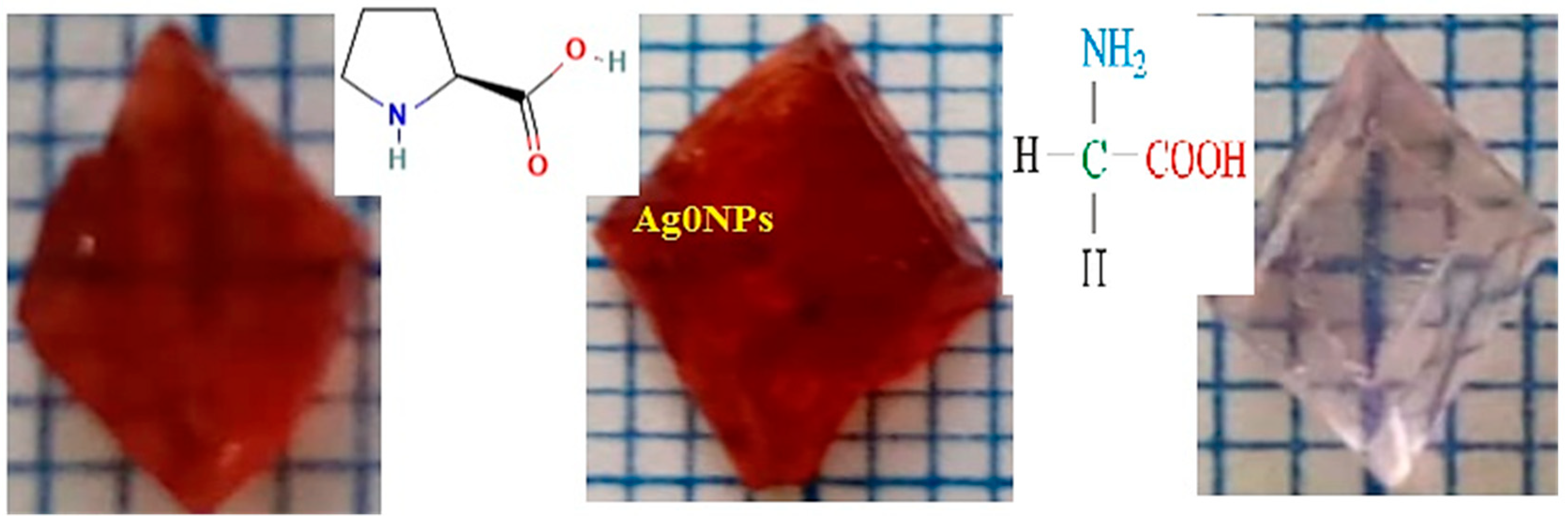
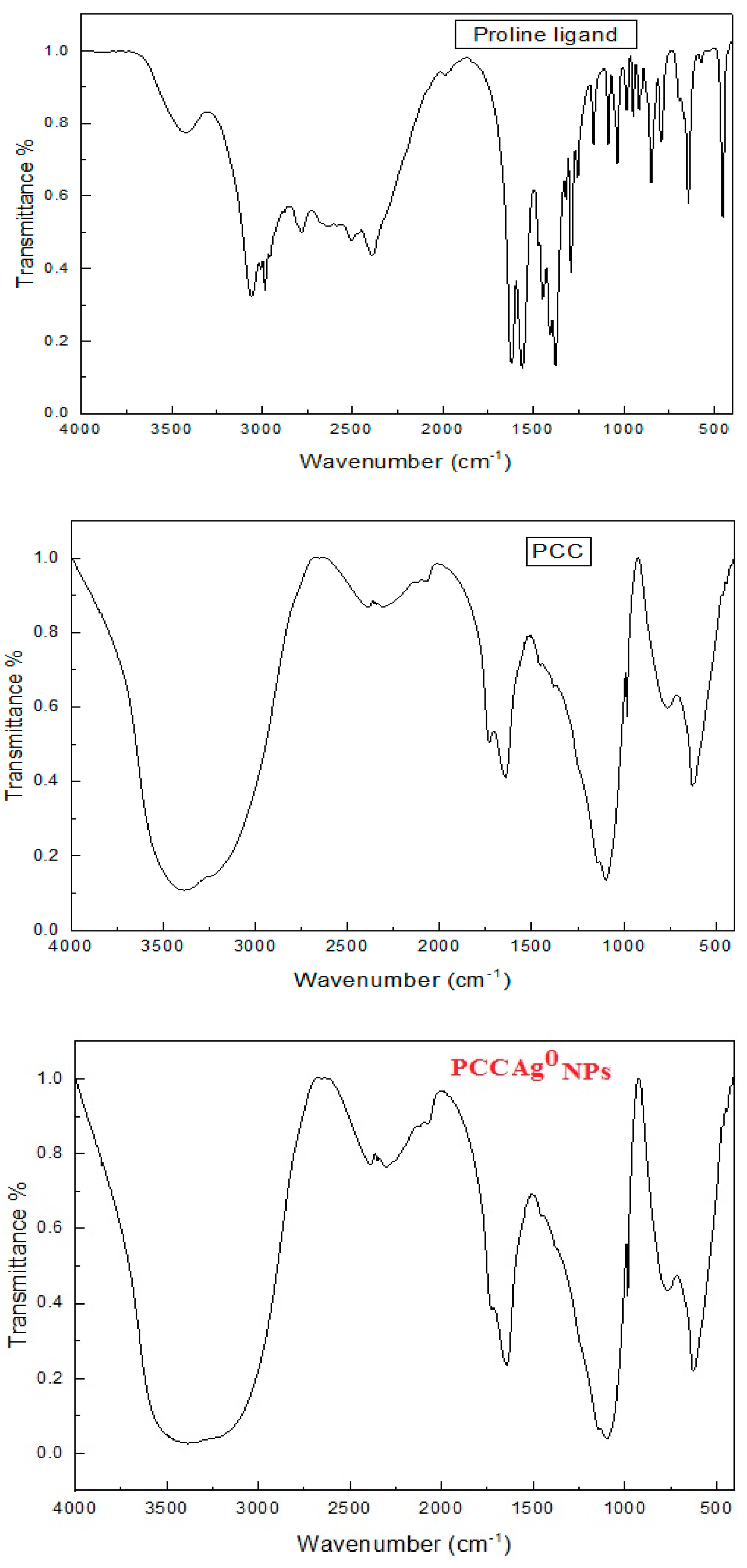

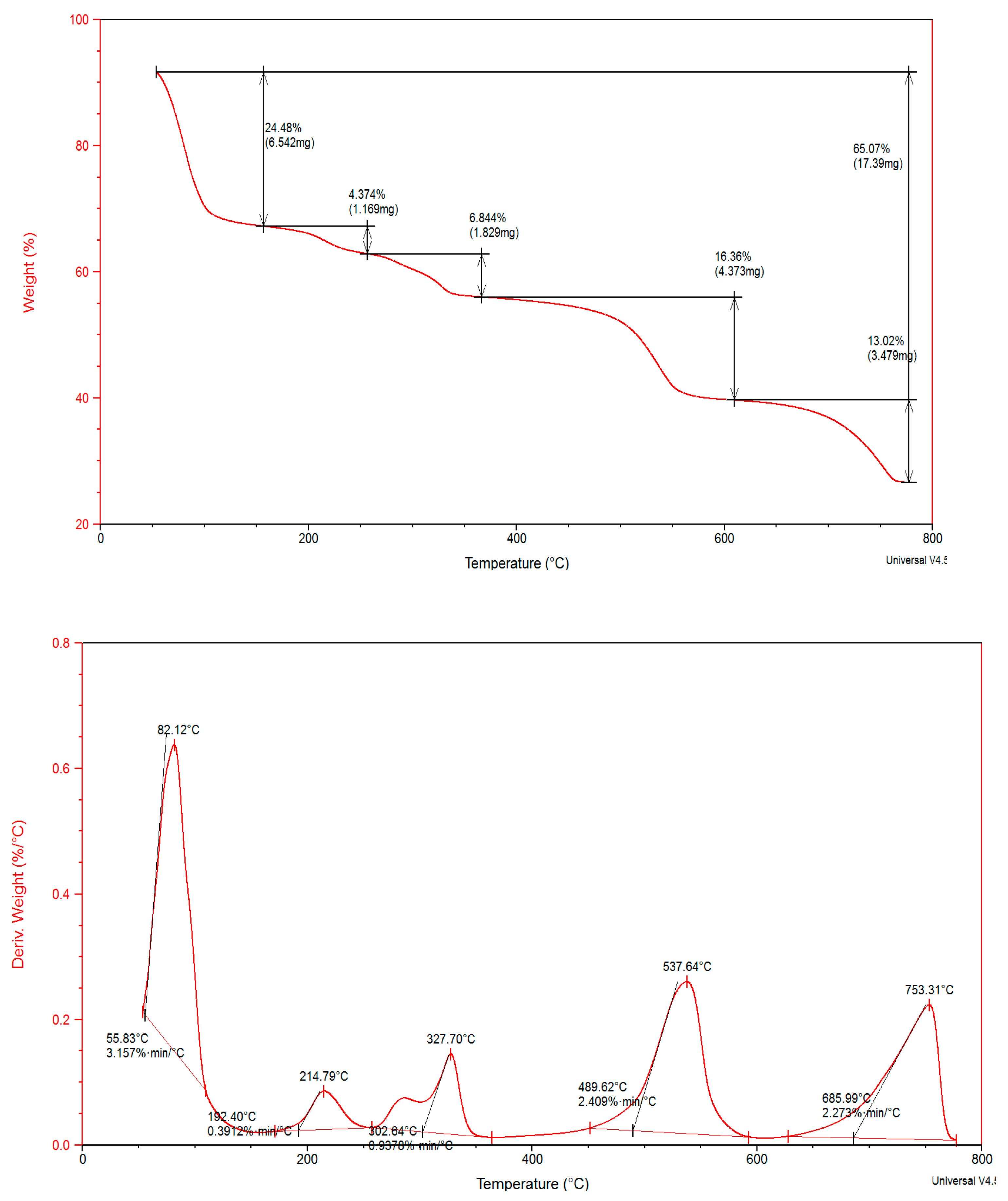
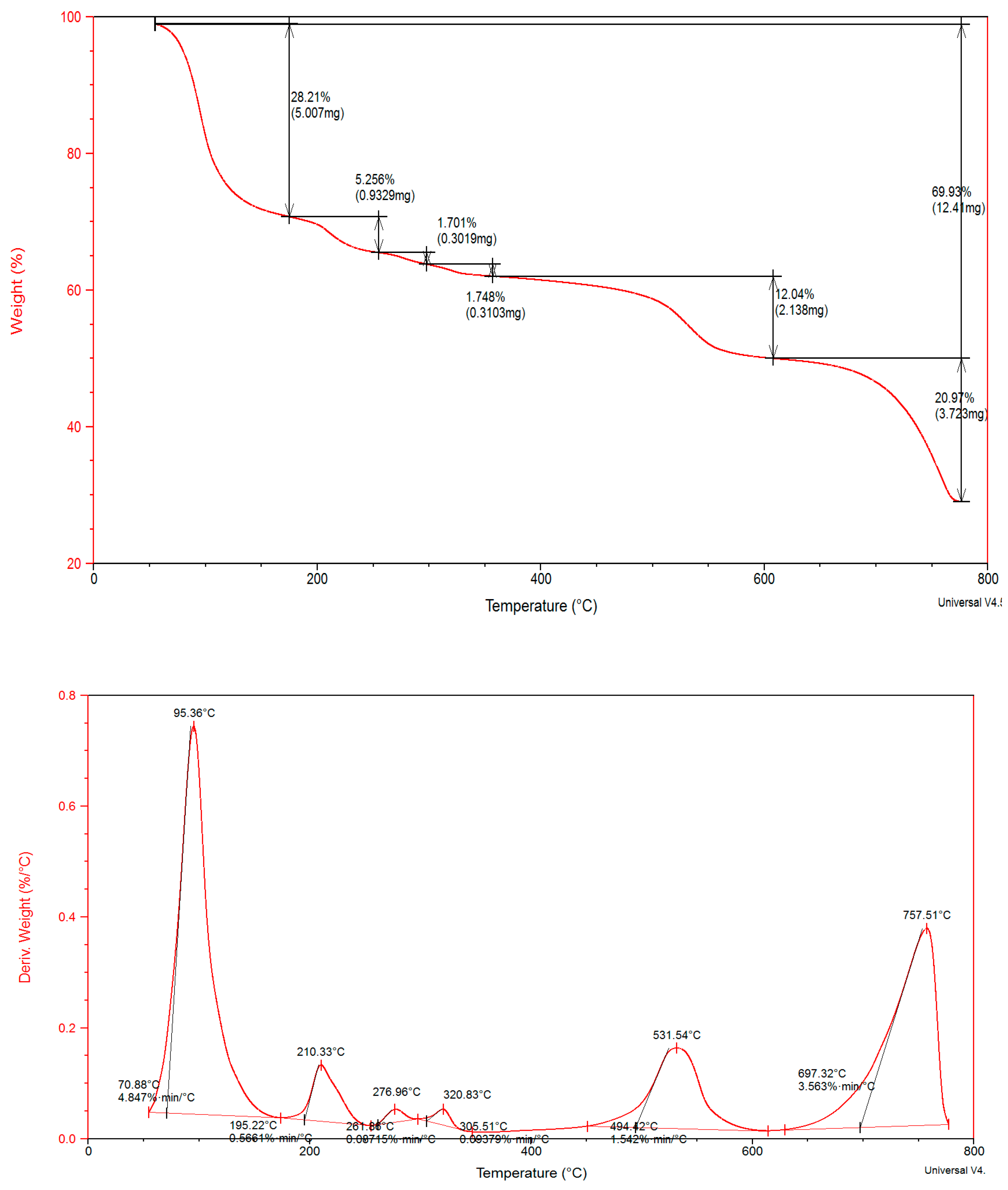
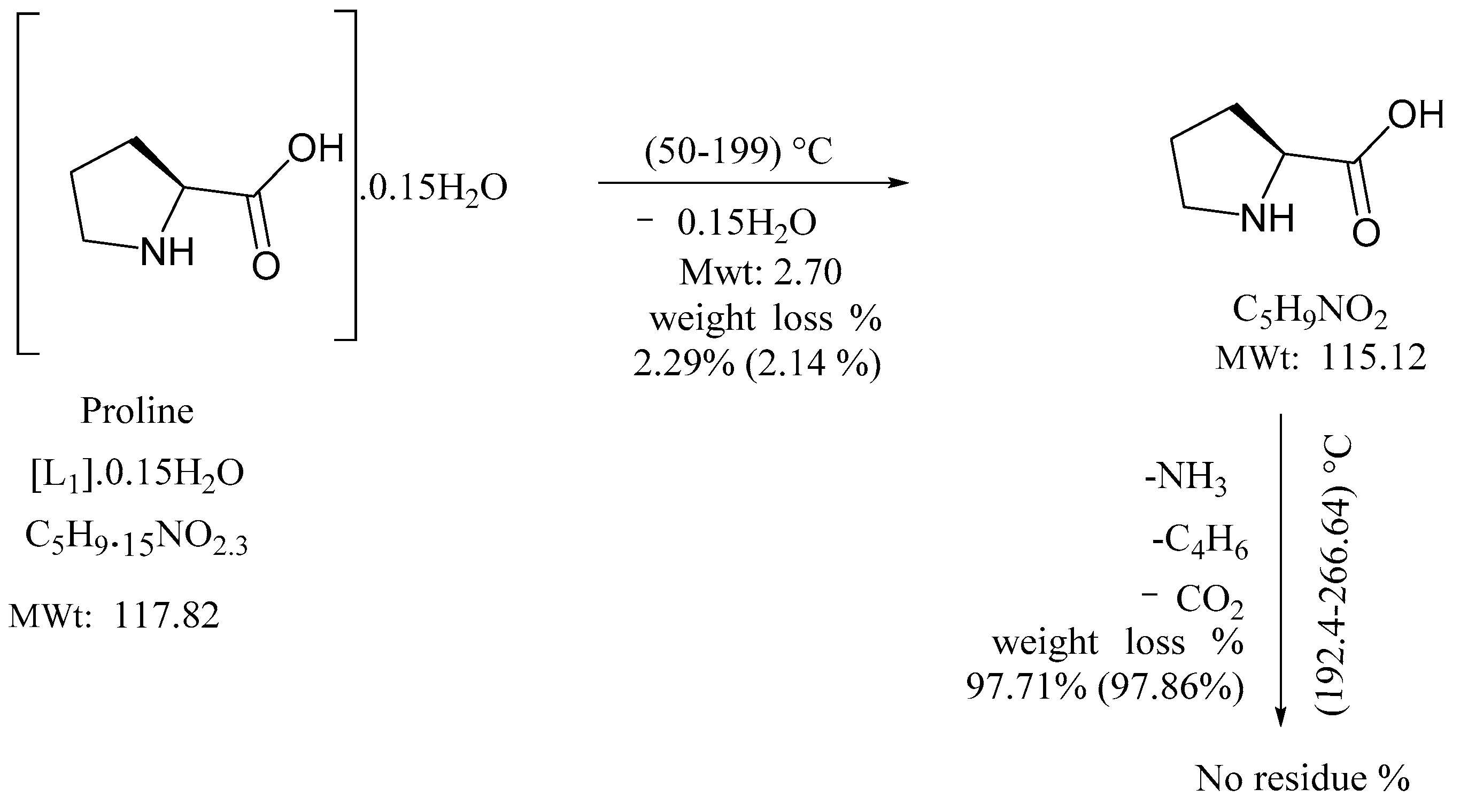

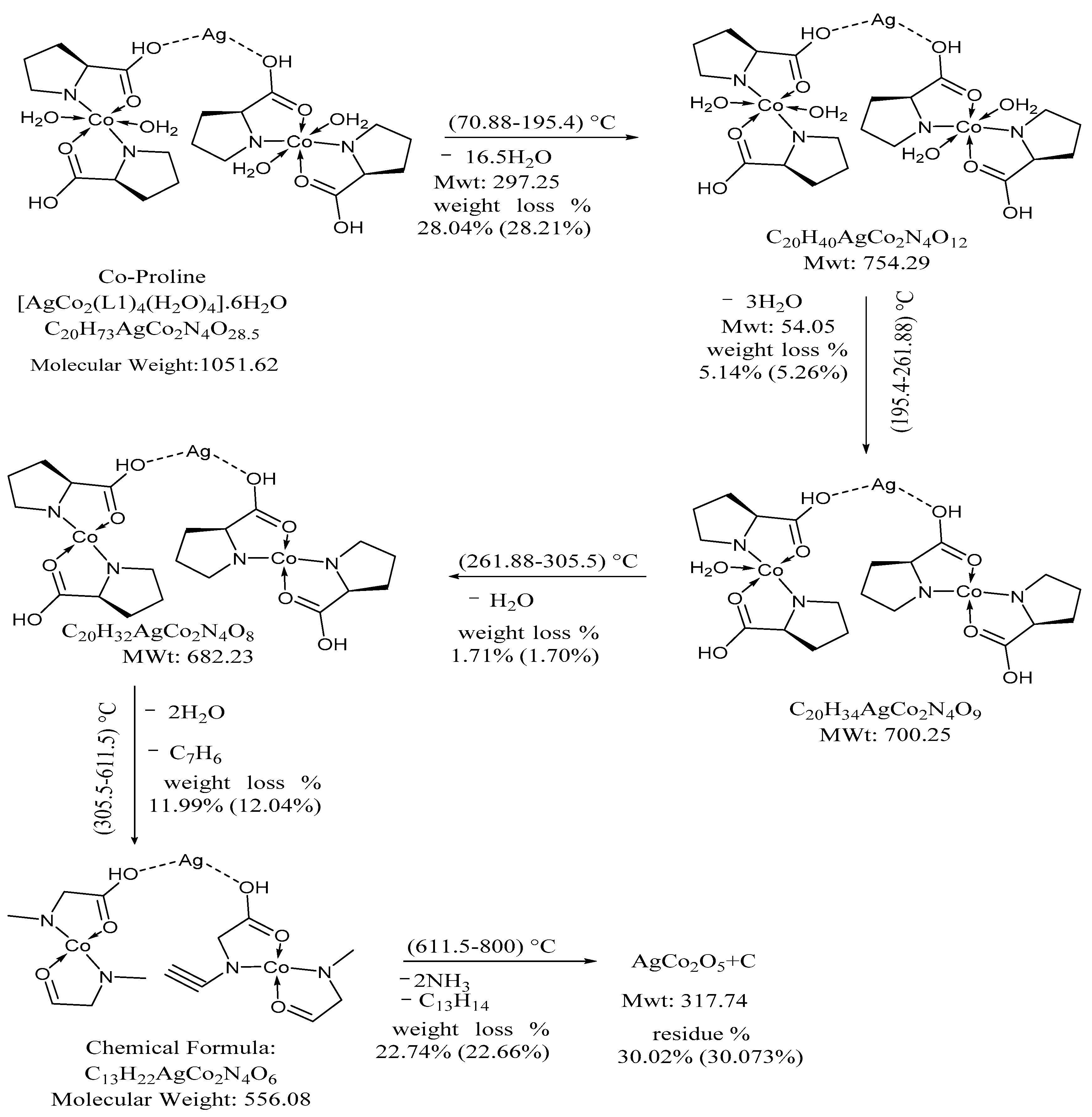



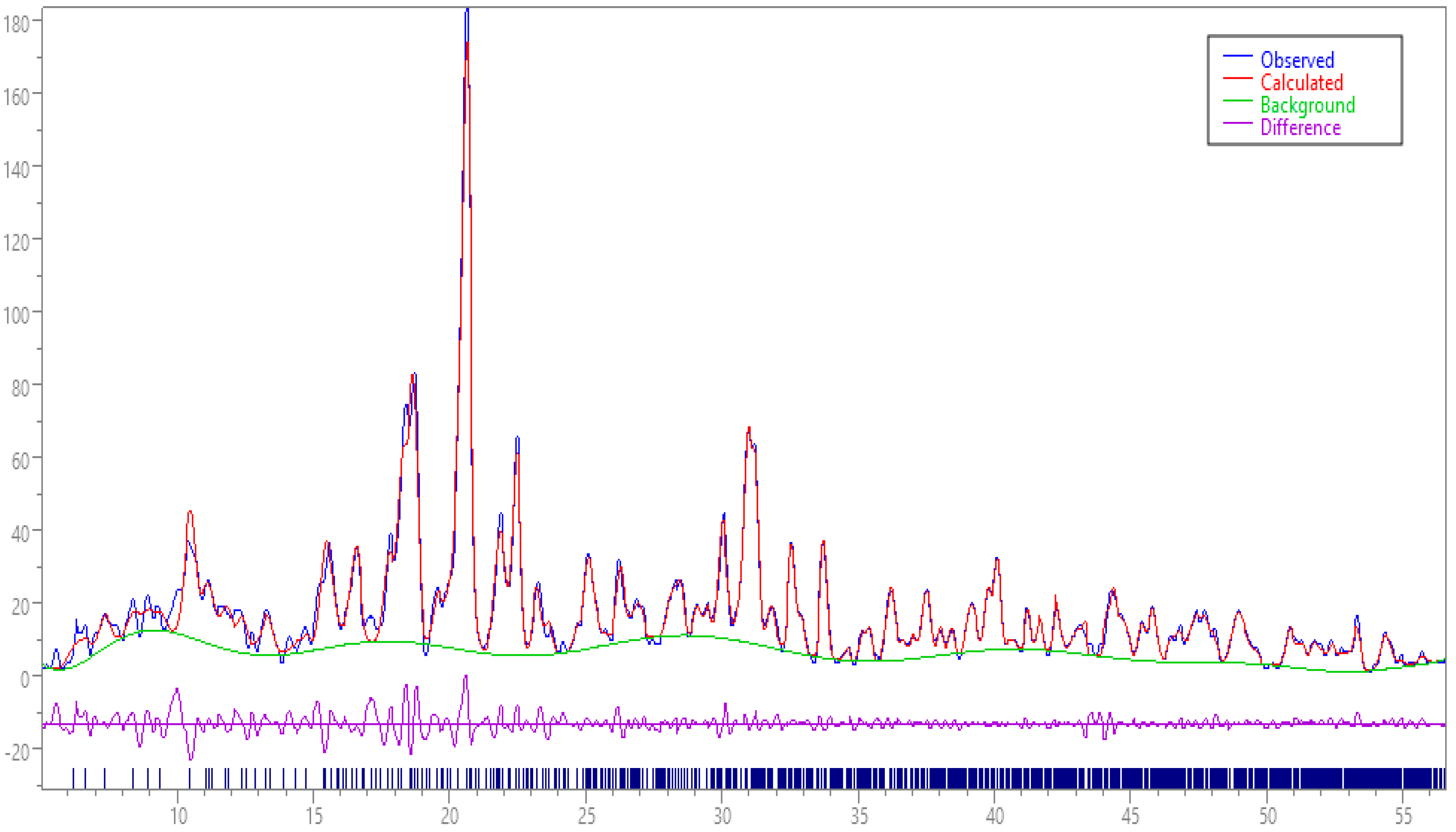
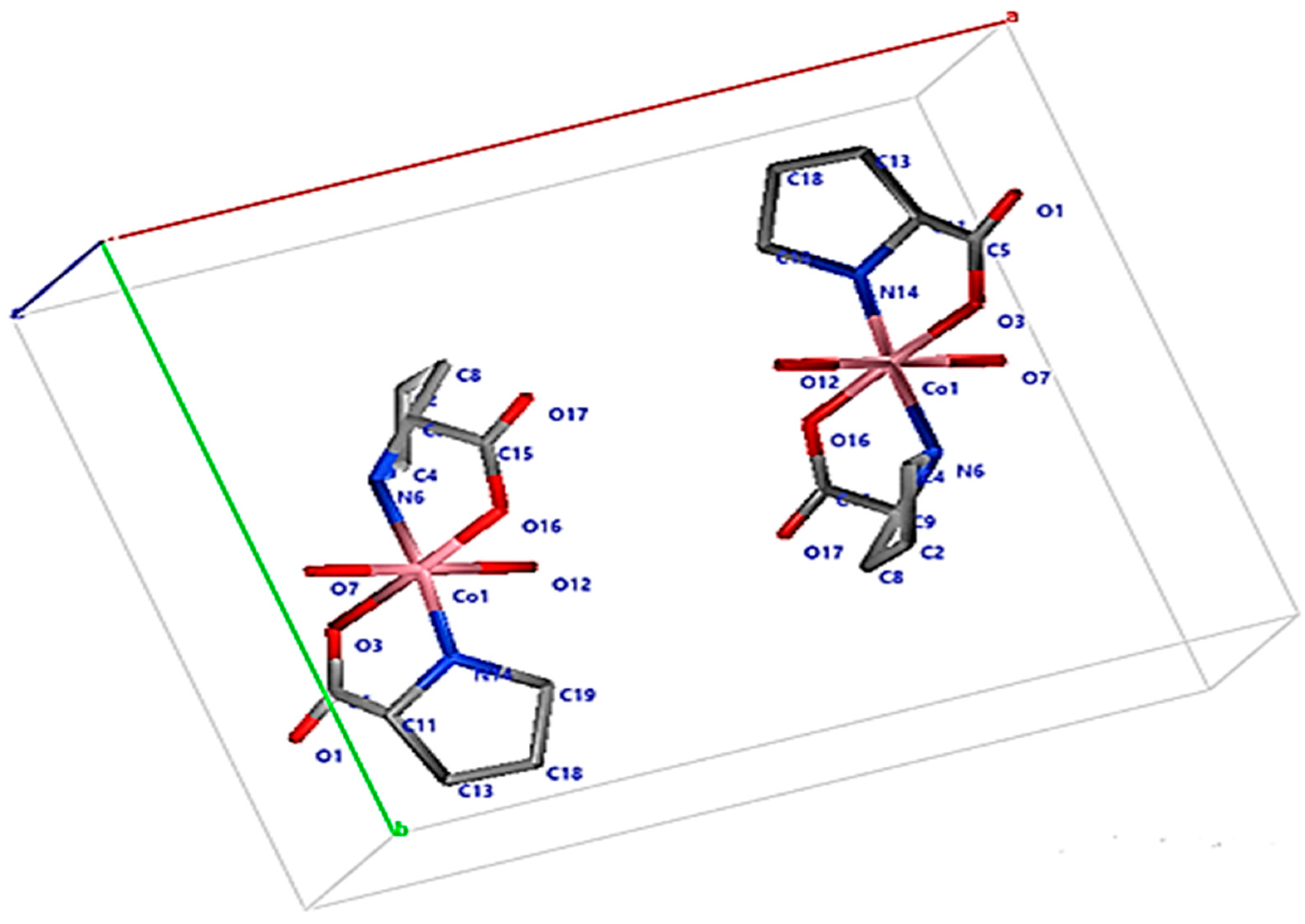

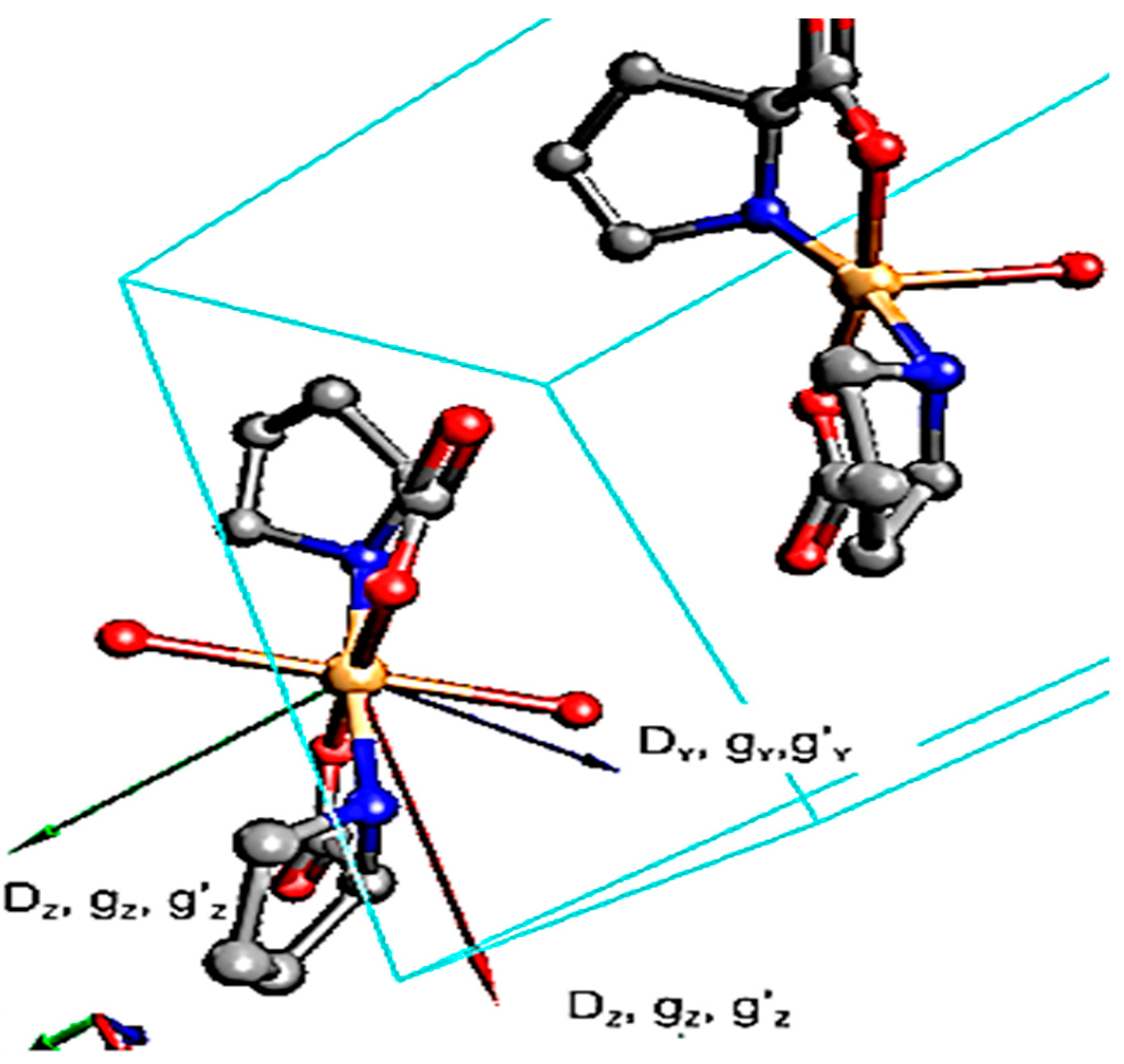
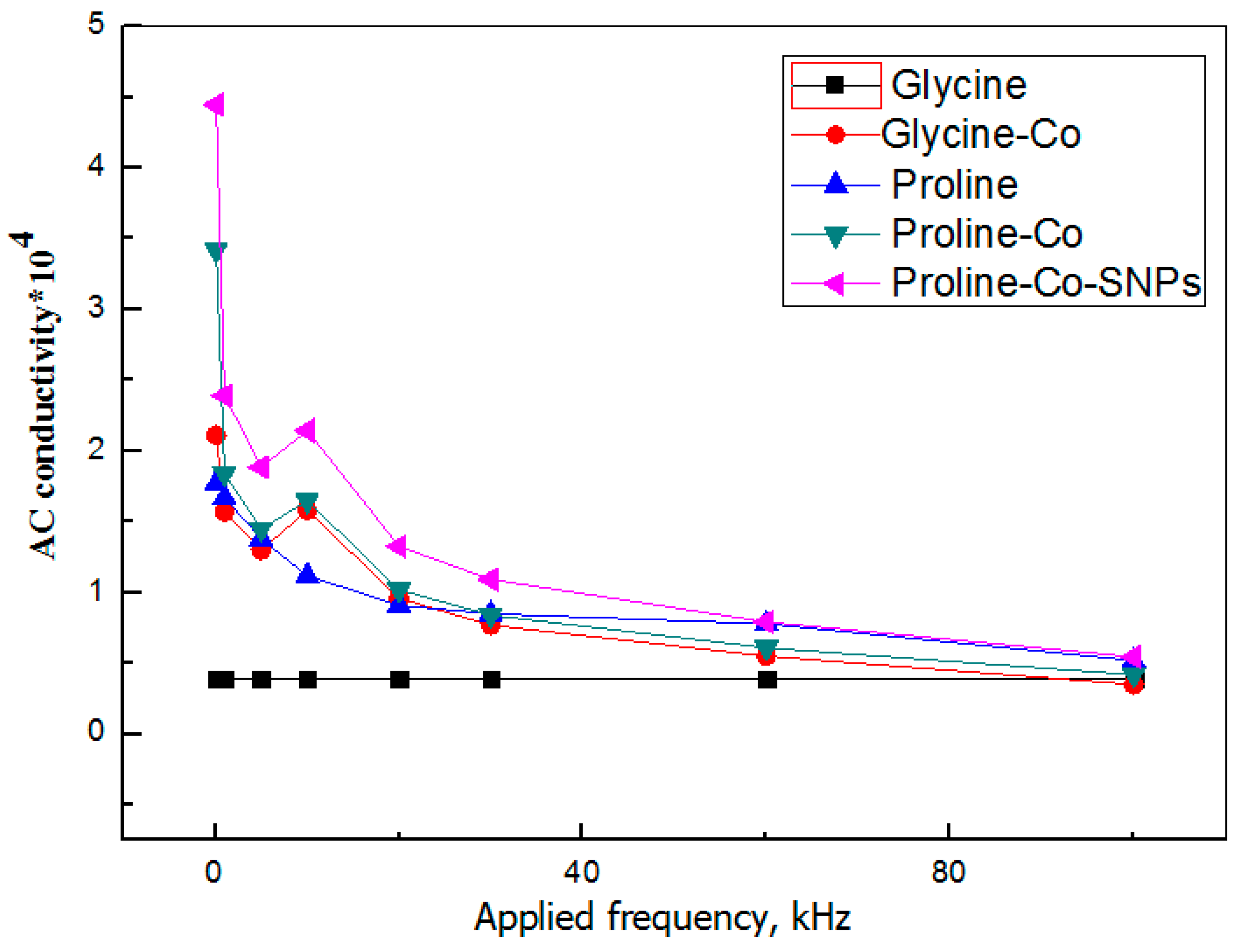

| Material | Symbol | Mw., g mol−1 | Purity |
|---|---|---|---|
| Proline (Sigma Aldrich Co.) | C5H9NO2 | 115.13 | 95% |
| Glycine (Oxford) (Oxford Co.) | C2H5NO2 | 75.07 | 98.5% |
| Co(II)chloride hexa-hydrate (Win-Lab Co.) | CoCl2·6H2O | 237.93 | 97% |
| Silver nanoparticles (Sigma Aldrich Co.) | Ag0NPs | Powder | 99.9% |
| No. | Crystal | F.W. (g mol−1) Color | Elemental Analysis Calculated/(Found) % | |||||
|---|---|---|---|---|---|---|---|---|
| C | H | N | O | Co | Ag | |||
| 1 | Proline | 115.13 White | 52.16 | 7.88 | 12.17 | 27.79 | - | - |
| 2 | PCC | 431.30 Pink | 27.85 (27.91) | 7.48 (7.36) | 6.50 (6.56) | 44.51 (44.37) | 13.66 (13.79) | - |
| 3 | PCCAg0NPs | 1051.54 Pink | 22.84 (22.94) | 7.00 (6.97) | 5.33 (5.48) | 43.36 (43.33) | 11.21 (11.00) | 10.26 (10.27) |
| 4 | Glycine | 75.07 White | 32.00 | 6.71 | 18.66 | 42.63 | - | - |
| 5 | Glycine CC | 351.171 Pale pink | 13.68 (13.71) | 6.89 (6.93) | 7.98 (7.88) | 54.67 (54.60) | 16.78 (16.87) | - |
| Crystal | UV Bands cm−1 × 103 | Assigned Band | −Ds | Dt | B′ | β | K1 × 102 | Dq | ν1 × 102 | DqZ | Dqxy × 103 | µeff (B.M.) | D | |
|---|---|---|---|---|---|---|---|---|---|---|---|---|---|---|
| PCC | ν6 + ν5 | 23 | 4A2g → 4A2g(a) 4A2g → 4Eg(C) | 694 | 347 | 753 | 0.77 | 30.4 | 664 | 13.5 | 664 | 1.3 | 4.44 | 32 |
| ν4 | 19 | 4A2g → 4B1g | ||||||||||||
| ν3 | 14 | 4A2g → 4Eg(b) | ||||||||||||
| ν2 | 11 | 4A2g → 4B2g | ||||||||||||
| PCCAg0NPs | ν6 + ν5 | 23 22 21 | 4A2g → 4A2g(a) 4A2g → 4Eg(C) | 646 | 323 | 595 | 0.61 | 28.3 | 744 | 12.9 | 686 | 1.3 | 4.55 | 29.8 |
| ν4 | 18 | 4A2g → 4B1g | ||||||||||||
| ν3 | 13 | 4A2g → 4Eg(b) | ||||||||||||
| ν2 | 10 | 4A2g → 4B2g | ||||||||||||
| Glycine-Co(II) | ν6 | 22 | 4A2g → 4A2g(a) | 642 | 321 | 525 | 0.54 | 28.1 | 642 | 12.8 | 722 | 1.3 | 4.65 | 28.4 |
| ν5 | 20 | 4A2g → 4Eg(C) | ||||||||||||
| ν4 | 17 | 4A2g → 4B1g | ||||||||||||
| ν3 | 14 | 4A2g → 4Eg(b) | ||||||||||||
| ν2 | 10 | 4A2g → 4B2g | ||||||||||||
| Sample | Tm °C | n | αm | Ea | Z S−1 | −ΔS# | −ΔH# | T, °C TGA | %wt. Loss | Lost Species | |
|---|---|---|---|---|---|---|---|---|---|---|---|
| Cal. | Found | ||||||||||
| Proline | 66 | 1.09 | 0.62 | 32.4 | 0.0115 | 0.30 | 102.16 | 50–199 | 2.29 | 2.14 | 0.15H2O |
| 244.3 | 1.05 | 0.63 | 12.5 | 0.002 | 0.32 | 164.09 | 192–266 | 97.71 | 97.86 | NH3, C4H6, CO2 | |
| PCC | 82.1 | 1.21 | 0.59 | 40.9 | 0.013 | 0.30 | 106.92 | 55–192 | 25.04 | 24.48 | 6H2O |
| 214.8 | 1.19 | 0.59 | 31.2 | 0.007 | 0.31 | 150.54 | 192–302 | 4.17 | 4.37 | H2O | |
| 327.7 | 0.82 | 0.66 | 264.22 | 0.052 | 0.31 | 176.8 | 302–366 | 6.96 | 6.88 | H2O, C | |
| 537.7 | 1.15 | 0.60 | 471.5 | 0.105 | 0.30 | 154.67 | 366–600 | 16.70 | 16.36 | 2H2O + 3C | |
| 753.38 | 0.85 | 0.66 | 184.6 | 0. 029 | 0.30 | 226.79 | 600–800 | 12.99 | 13.02 | 2NH3, 3H2, CoO + 6C | |
| PCCAg0NPs | 95.4 | 1.24 | 0.59 | 28.6 | 0.009 | 0.30 | 112.22 | 70–195 | 28.04 | 28.21 | 16.5H2O |
| 210.3 | 1.11 | 0.61 | 31.2 | 0.007 | 0.31 | 150.54 | 195–261 | 5.14 | 5.26 | 3H2O | |
| 327.7 | 0.94 | 0.64 | 255.9 | 0.051 | 0.29 | 176.96 | 261–305 | 1.71 | 1.70 | H2O | |
| 531.5 | 1.08 | 0.61 | 241.2 | 0.054 | 0.29 | 155.81 | 305–611 | 11.99 | 12.04 | 2H2O + C7H6 | |
| 757.5 | 0.84 | 0.66 | 71.1 | 0.011 | 0.30 | 232.77 | 612–800 | 22.74 | 22.66 | 2NH3, C13H14, AgCo2O5 + C | |
| Unit cell parameters | [Co(L1)2(H2O)2] | [AgCo(L1)4(H2O)4] |
| Formula | C10H20CoN2O6 | C20H40AgCo2N4O12 |
| Formula weight, g/mol. | 323.21 | 754.29 |
| Crystal System | Triclinic | Triclinic |
| Space Group | P-1 (No. 2) | P-1 (No. 1) |
| A, Å | 13.74757 | 15.60238 |
| B, Å | 12.07775 | 14.31124 |
| C, Å | 7.53226 | 11.10404 |
| α, ° | 93.259 | 99.005 |
| β, ° | 104.802 | 102.769 |
| γ, ° | 86.210 | 107.207 |
| V, Å3 | 1205.469 | 2254.13 |
| ρ (g/cm) | 0.851 | 1.069 |
| Volume per atom, Å3 | 19.432 | 28.891 |
| Z | 2 | 2 |
| Rp | 3.28% | 3.99% |
| Rwp | 5.88% | 6.12% |
| S | 2.03 | 0.97 |
| PCC | PCCAg0NPs | ||||||||||||
|---|---|---|---|---|---|---|---|---|---|---|---|---|---|
| h | k | ℓ | 2Theta (Exp.) | D Exp.) | Int. (Exp.) | FWHM | h | k | ℓ | 2Theta (Exp.) | d (Exp.) | Int. | FWHM |
| 0 | 1 | 0 | 6.654 | 13.272 | 20.33 | 0.76543 | 1 | 1 | 0 | 10.490 | 8.42 | 34.66 | 0.32452 |
| 0 | 0 | 1 | 12.154 | 7.276 | 105.49 | 1.88051 | 0 | 2 | 0 | 13.252 | 6.675 | 12.18 | 0.18225 |
| 0 | 0 | −1 | 13.946 | 6.344 | 63.43 | 0.00997 | 2 | 1 | −1 | 15.452 | 5.729 | 37.18 | 0.29556 |
| 0 | 1 | 1 | 14.470 | 6.116 | 66.52 | 1.4298 | 1 | 1 | −2 | 15.452 | 5.729 | 35.14 | 0.33545 |
| 2 | −1 | −1 | 17.793 | 4.980 | 96.08 | 0.90967 | 3 | 0 | 0 | 18.602 | 4.765 | 81.98 | 0.25665 |
| 2 | 0 | 0 | 19.534 | 4.582 | 65.26 | 0.50756 | 2 | 1 | 1 | 20.299 | 4.371 | 183.18 | 0.78236 |
| 2 | 0 | 1 | 20.491 | 4.382 | 86.25 | 1.27848 | 1 | 3 | −1 | 21.979 | 4.040 | 35.38 | 0.01823 |
| 0 | 3 | 0 | 22.129 | 4.013 | 87.25 | 0.02562 | 2 | −1 | 2 | 22.215 | 3.998 | 50.90 | 0.08756 |
| 3 | 2 | −1 | 24.514 | 3.628 | 22.35 | 0.64726 | 1 | −3 | 2 | 23.187 | 3.832 | 25.47 | 1.02088 |
| 1 | −2 | 2 | 30.531 | 2.925 | 37.97 | 0.62245 | 2 | −3 | 2 | 25.095 | 3.545 | 33.61 | 0.02479 |
| 2 | −3 | −2 | 34.605 | 2.589 | 64.69 | 0.45848 | 2 | −1 | −3 | 26.270 | 3.989 | 31.57 | 0.67286 |
| 5 | 2 | −2 | 38.398 | 2.342 | 40.43 | 0.68259 | 3 | −2 | −3 | 29.992 | 2.976 | 30.25 | 0.91575 |
| 4 | 2 | 2 | 43.780 | 2.066 | 22.32 | 0.96378 | 2 | 3 | −3 | 30.939 | 2.887 | 60.16 | 0.56195 |
| 5 | 2 | −3 | 45.175 | 2.005 | 24.41 | 0.41315 | 3 | −4 | −2 | 32.439 | 2.757 | 36.67 | 0.15566 |
| 1 | −4 | −3 | 48.504 | 1.875 | 48.12 | 0.10856 | 2 | −5 | −1 | 33.804 | 2.649 | 34.91 | 0.02654 |
| 1 | 4 | 3 | 50.843 | 1.794 | 33.60 | 0.17348 | 2 | 4 | 1 | 36.827 | 2.438 | 28.09 | 0.15232 |
| 1 | −4 | −4 | 60.421 | 1.530 | 23.25 | 0.02562 | 6 | −3 | −2 | 37.415 | 2.401 | 30.70 | 0.01225 |
| 8 | 5 | 0 | 66.672 | 1.401 | 17.68 | 0.42620 | 0 | 6 | −2 | 40.039 | 2.250 | 39.56 | 0.01892 |
| 1 | −3 | 5 | 44.249 | 2.045 | 25.65 | 0.56254 | |||||||
| 4 | 5 | 0 | 49.031 | 1.856 | 24.62 | 0.05625 | |||||||
| S’= 1/2 | g′-: [1.985646 2.340553 1.854218] | iso = 2.058097 | ||
|---|---|---|---|---|
| X | 0.5596427 | 0.0403302 | 0.43705684 | |
| Y | 0.2030645 | 0.6744556 | −0.0008985 | |
| Z | 0.5000569 | 0.1058385 | 0.6994335 | |
| S = 3/2 | g-: [2.0283318 2.408440 1.972264] | iso = 2.445768 | ||
| X | 0.5147588 | 0.0004222 | 0.2415496 | |
| Y | 0.0000717 | 0.2344554 | 0.00108912 | |
| Z | 0.4465498 | 0.4014065 | −0.43434481 | |
| S = 3/2 | D-tensor eigenvalues (traceless) (cm−1) | |||
| −4.327026 | −14.800230 | −25.127257 | ||
| X | 0.899270 | 0.0004222 | 0.437394 | |
| Y | 0.000160 | 0.340000 | 0.000897 | |
| Z | 0.421364 | 0.0100833 | −0.899270 | |
| Crystal | D (cm−1) | E (cm−1) | Excitation Energy Δ (cm−1) |
|---|---|---|---|
| PCC | 91.2 | 7.2 | 193.2 |
| PCCAg0NPs | 63.3 | 6.6 | 145.1 |
| Sample | Bacterial Strain | Fungal Strain | ||||||
|---|---|---|---|---|---|---|---|---|
| Gram (+) | Gram (−) | |||||||
| S. aureus | E.faecalis | S. Typhi | E. coli | P. aeruginosa | K. pneumoniae | A. braselienses | C. albicans | |
| Proline | - | - | - | - | - | - | - | - |
| PCC | 19 | 20 | 23 | 20 | 25 | 24 | - | 39 |
| PCCAg0NPs | 21 | 25 | 24 | 26 | 30 | 28 | 12 | 46 |
| Ciprofloxacin | 23 | - | 26 | 26 | 25 | - | - | - |
| IC50 | ||
|---|---|---|
| Sample | MCF-7 | MRC-5 |
| Cisplatin | 11.7 | 30.2 |
| PCC | 190.6 | 295.8 |
| PCCAg0NPs | 22.1 | 145.5 |
Disclaimer/Publisher’s Note: The statements, opinions and data contained in all publications are solely those of the individual author(s) and contributor(s) and not of MDPI and/or the editor(s). MDPI and/or the editor(s) disclaim responsibility for any injury to people or property resulting from any ideas, methods, instructions or products referred to in the content. |
© 2023 by the authors. Licensee MDPI, Basel, Switzerland. This article is an open access article distributed under the terms and conditions of the Creative Commons Attribution (CC BY) license (https://creativecommons.org/licenses/by/4.0/).
Share and Cite
Almufarij, R.S.; Ali, A.E.; Elbah, M.E.; Elmaghraby, N.S.; Khashaba, M.A.; Abdel-Hamid, H.; Fetouh, H.A. Preparation, Characterization of New Antimicrobial Antitumor Hybrid Semi-Organic Single Crystals of Proline Amino Acid Doped by Silver Nanoparticles. Biomedicines 2023, 11, 360. https://doi.org/10.3390/biomedicines11020360
Almufarij RS, Ali AE, Elbah ME, Elmaghraby NS, Khashaba MA, Abdel-Hamid H, Fetouh HA. Preparation, Characterization of New Antimicrobial Antitumor Hybrid Semi-Organic Single Crystals of Proline Amino Acid Doped by Silver Nanoparticles. Biomedicines. 2023; 11(2):360. https://doi.org/10.3390/biomedicines11020360
Chicago/Turabian StyleAlmufarij, R. S., A. E. Ali, M. E. Elbah, N. S. Elmaghraby, M. A. Khashaba, H. Abdel-Hamid, and H. A. Fetouh. 2023. "Preparation, Characterization of New Antimicrobial Antitumor Hybrid Semi-Organic Single Crystals of Proline Amino Acid Doped by Silver Nanoparticles" Biomedicines 11, no. 2: 360. https://doi.org/10.3390/biomedicines11020360






